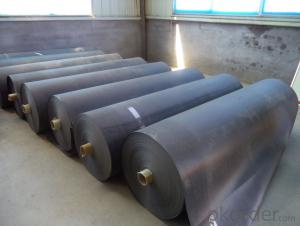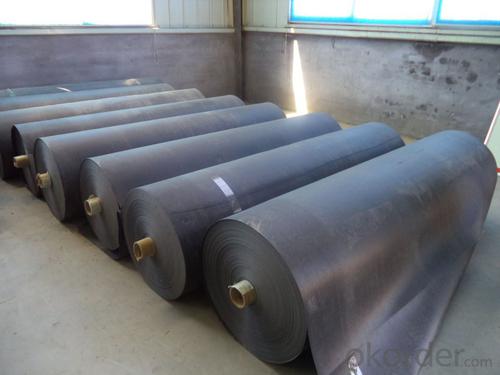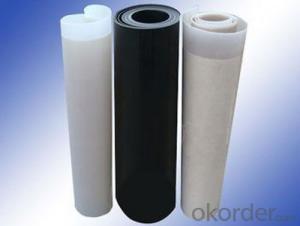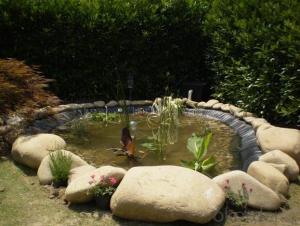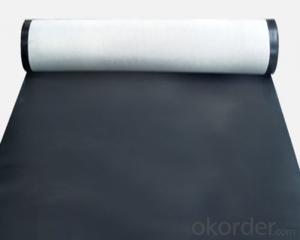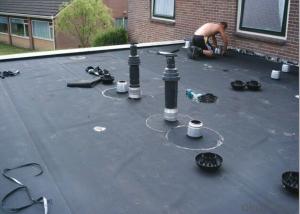EPDM rubber waterproof membrane for roofs
- Loading Port:
- Qingdao
- Payment Terms:
- TT OR LC
- Min Order Qty:
- 500 m²
- Supply Capability:
- 1000000 m²/month
OKorder Service Pledge
OKorder Financial Service
You Might Also Like
1. Introduction
| EPDM waterproof membrane is made from ternary ethylene-propylene
rubber, which is for waterproofing of exposed and non-exposed applications.
| EPDM waterproof membrane production adopts the world-advanced equipment of
cold feeding extrusion and continuous vulcanization technology.
| EPDM waterproof membrane is of high elasticity among high polymer waterproof materials and becomes a world-popular waterproofing material.
2. Specification
1) Material: EPDM Rubber
2) Size: 1.2m (width)*20m (length) or customized,
3) Thick: 1.2mm, 1.5mm, 2.0mm
4) Type: vulcanized
5) Pattern: Non-reinforced (homogeneous)
6) Heat resistance to 150 celsius degree
6) Certificate: ISO9001/14001
3. Features
| Excellent physical and mechanical performance
| High tearing resistance
| Good deformation adaptability
| High puncture resistance
| High aging resistance
- Q: Can a waterproofing membrane be used in bathrooms?
- Yes, a waterproofing membrane can be used in bathrooms. In fact, it is highly recommended to use a waterproofing membrane in bathrooms to prevent water damage and leakage. The membrane is typically applied on the walls and floors, creating a barrier that prevents water from seeping through and causing structural damage or mold growth. This is especially important in areas such as showers and around bathtubs where water exposure is high. Waterproofing membranes are designed to withstand moisture and provide long-lasting protection, ensuring the integrity of the bathroom and extending its lifespan.
- Q: Can waterproofing membranes be used on utility tunnels?
- Yes, waterproofing membranes can be used on utility tunnels. Utility tunnels are often subjected to moisture and water infiltration, and using waterproofing membranes can help prevent water damage and ensure the longevity of the tunnel structure. Waterproofing membranes are designed to create a barrier between the structure and the surrounding environment, effectively preventing water from seeping into the tunnel. These membranes are typically made from materials such as bitumen or synthetic polymers, which are highly resistant to water penetration. By applying these membranes to the walls, floors, and ceilings of utility tunnels, they can effectively protect the structure from water damage, including leaks, cracks, and deterioration. Additionally, waterproofing membranes also help to maintain the integrity of utility tunnels by preventing the ingress of harmful substances such as chemicals or pollutants. Overall, using waterproofing membranes on utility tunnels is an effective method to ensure their durability and functionality in the long term.
- Q: Can a waterproofing membrane be applied on any surface?
- A waterproofing membrane can be applied on a variety of surfaces, but it is important to consider the specific characteristics and requirements of each surface before proceeding. While many waterproofing membranes are versatile and can adhere to different materials, it is recommended to consult with a professional or manufacturer to ensure compatibility and optimal performance. For concrete surfaces, waterproofing membranes can be applied to prevent water penetration and protect against moisture damage. These membranes are typically designed to adhere to concrete and provide a barrier against water and vapor transmission. However, it is important to properly prepare the concrete surface by cleaning, repairing any cracks or imperfections, and ensuring a smooth and even substrate for the membrane. Similarly, waterproofing membranes can be applied to masonry surfaces such as brick or stone. These surfaces may require additional preparation, such as removing loose mortar or debris, and may benefit from a primer to enhance adhesion. Additionally, certain types of waterproofing membranes may be more suitable for these surfaces depending on their porosity and texture. Waterproofing membranes can also be applied to wood surfaces, such as decks or balconies, to protect against moisture damage and extend their lifespan. However, it is important to select a membrane specifically designed for wood surfaces as they may require additional flexibility to accommodate the natural movement and expansion of the wood. In summary, while a waterproofing membrane can be applied on various surfaces, it is crucial to consider the specific characteristics and preparation requirements of each surface to achieve optimal results. Consulting with a professional or manufacturer can help determine the most suitable membrane and application method for a particular surface.
- Q: Can a waterproofing membrane be used on tunnels with fire protection systems?
- Tunnels equipped with fire protection systems can indeed make use of a waterproofing membrane. It is actually quite common to recommend the use of a waterproofing membrane alongside fire protection systems in tunnels, as it adds an extra layer of safeguarding. The purpose of this membrane is to prevent any water from infiltrating the tunnel, as this could potentially harm the fire protection systems and undermine their effectiveness. By ensuring the tunnel remains watertight, the waterproofing membrane preserves the integrity and functionality of the fire protection systems, enabling them to fulfill their intended purpose in the event of a fire. Moreover, the waterproofing membrane can also serve as a barrier, impeding the spread of fire by blocking the passage of flames and smoke. Nonetheless, it is crucial to ensure that the chosen waterproofing membrane is compatible with the specific fire protection systems employed in the tunnel in order to ensure optimum performance and safety.
- Q: Can a waterproofing membrane be used in areas with heavy foot traffic or vehicle loadings?
- Yes, a waterproofing membrane can be used in areas with heavy foot traffic or vehicle loadings. However, it is important to ensure that the membrane selected is designed specifically for such conditions and is capable of withstanding the expected loads and pressures. Additionally, regular maintenance and inspections are necessary to ensure the membrane remains intact and functional in high-traffic areas.
- Q: Can a waterproofing membrane be used for convention centers or exhibition halls?
- Yes, a waterproofing membrane can definitely be used for convention centers or exhibition halls. These types of buildings often have large areas of flat roofs or underground spaces that are prone to water leakage. A waterproofing membrane is a durable and effective solution to prevent water infiltration and protect the structure from potential damage. Convention centers and exhibition halls are subject to heavy foot traffic and can experience high levels of moisture due to the presence of various activities, such as trade shows, concerts, and conferences. Waterproofing membranes provide a seamless and watertight barrier that effectively keeps water out, ensuring the integrity and durability of the building. Additionally, waterproofing membranes can be applied to different types of surfaces, including concrete, metal, and wood, making them suitable for various construction materials commonly used in convention centers and exhibition halls. They can be installed underneath flooring systems, on walls, or as a protective layer on roofs, providing comprehensive water protection for the entire structure. Moreover, waterproofing membranes come in different forms, such as liquid-applied membranes, sheet membranes, or spray-applied coatings. This versatility allows for flexibility in choosing the most appropriate type of membrane based on the specific requirements and conditions of the convention center or exhibition hall. In summary, a waterproofing membrane is an excellent choice for convention centers or exhibition halls due to its ability to prevent water penetration, protect the structure from potential damage, and ensure the longevity of the building.
- Q: How is a waterproofing membrane installed?
- To achieve proper installation and effective waterproofing, the installation process of a waterproofing membrane usually follows a step-by-step approach. Here is a general outline of how the installation takes place: 1. Surface Preparation: The initial step involves preparing the surface where the membrane will be installed. This necessitates a thorough cleaning of the surface, eliminating any dirt, debris, or loose materials. The objective is to create a clean and smooth surface to ensure optimal adhesion of the membrane. 2. Priming: Subsequently, a primer is applied to the surface to enhance the adhesion between the membrane and the substrate. It also provides a uniform surface for the membrane to adhere to. 3. Membrane Application: The next step involves applying the waterproofing membrane onto the prepared surface. There are various types of membranes available, such as sheet membranes or liquid-applied membranes. Sheet membranes are typically rolled out onto the surface and adhered using a suitable adhesive or self-adhesive backing. Liquid-applied membranes are spread or sprayed onto the surface in multiple coats, allowing each coat to cure before applying the next one. 4. Seam and Joint Treatment: In areas where multiple sheets or sections of the membrane intersect, special attention is given to treating the seams and joints to ensure a watertight seal. This may entail overlapping the sheets and applying a seam tape or using a liquid-applied sealant to fill any gaps or joints. 5. Protection and Drainage: Once the membrane is installed, it is crucial to safeguard it from damage and facilitate proper drainage. This can be achieved by installing a protective layer, such as a geotextile fabric or a drainage board, over the membrane. These layers serve to prevent punctures or abrasions and allow any water that penetrates the surface to drain away effectively. 6. Quality Control: After the completion of the installation, it is essential to conduct quality control checks to ensure the correct installation of the membrane. This may involve visual inspections, water tests, or the utilization of specialized equipment to test the integrity of the membrane. It should be noted that the specific installation process may vary depending on the type of waterproofing membrane employed and the requirements of the project. It is advisable to adhere to the manufacturer's guidelines and consult with a professional waterproofing contractor for accurate installation instructions.
- Q: Is the foundation pit waterproofing and the foundation pouring on the working face?
- 3, you say waterproof and pouring concrete conflict? Do not conflict
- Q: What is the accounting subject of the waterproofing membrane
- For external construction, included in the construction Self-service maintenance, included in the manufacturing costs (management costs)
- Q: Can a waterproofing membrane be used for chemical storage facilities?
- Yes, a waterproofing membrane can be used for chemical storage facilities. It provides an effective barrier against moisture and can help prevent leaks or spills from contaminating the surrounding environment. However, it is important to ensure that the membrane is compatible with the specific chemicals being stored to avoid any potential chemical reactions or degradation of the membrane itself. Additionally, proper ventilation and safety measures should be in place to address any potential chemical hazards.
Send your message to us
EPDM rubber waterproof membrane for roofs
- Loading Port:
- Qingdao
- Payment Terms:
- TT OR LC
- Min Order Qty:
- 500 m²
- Supply Capability:
- 1000000 m²/month
OKorder Service Pledge
OKorder Financial Service
Similar products
Hot products
Hot Searches
Related keywords
